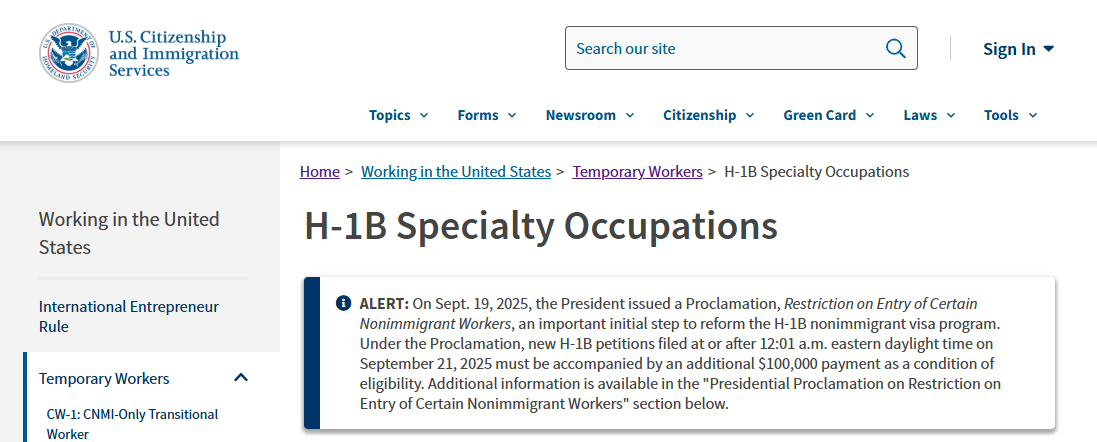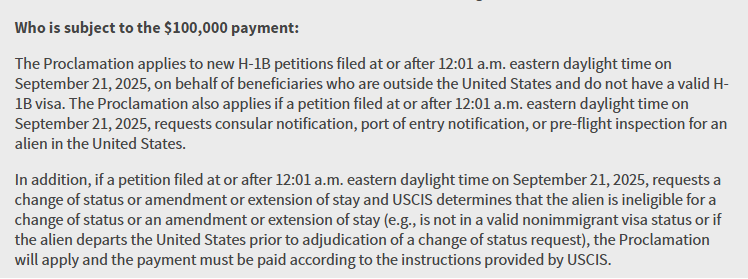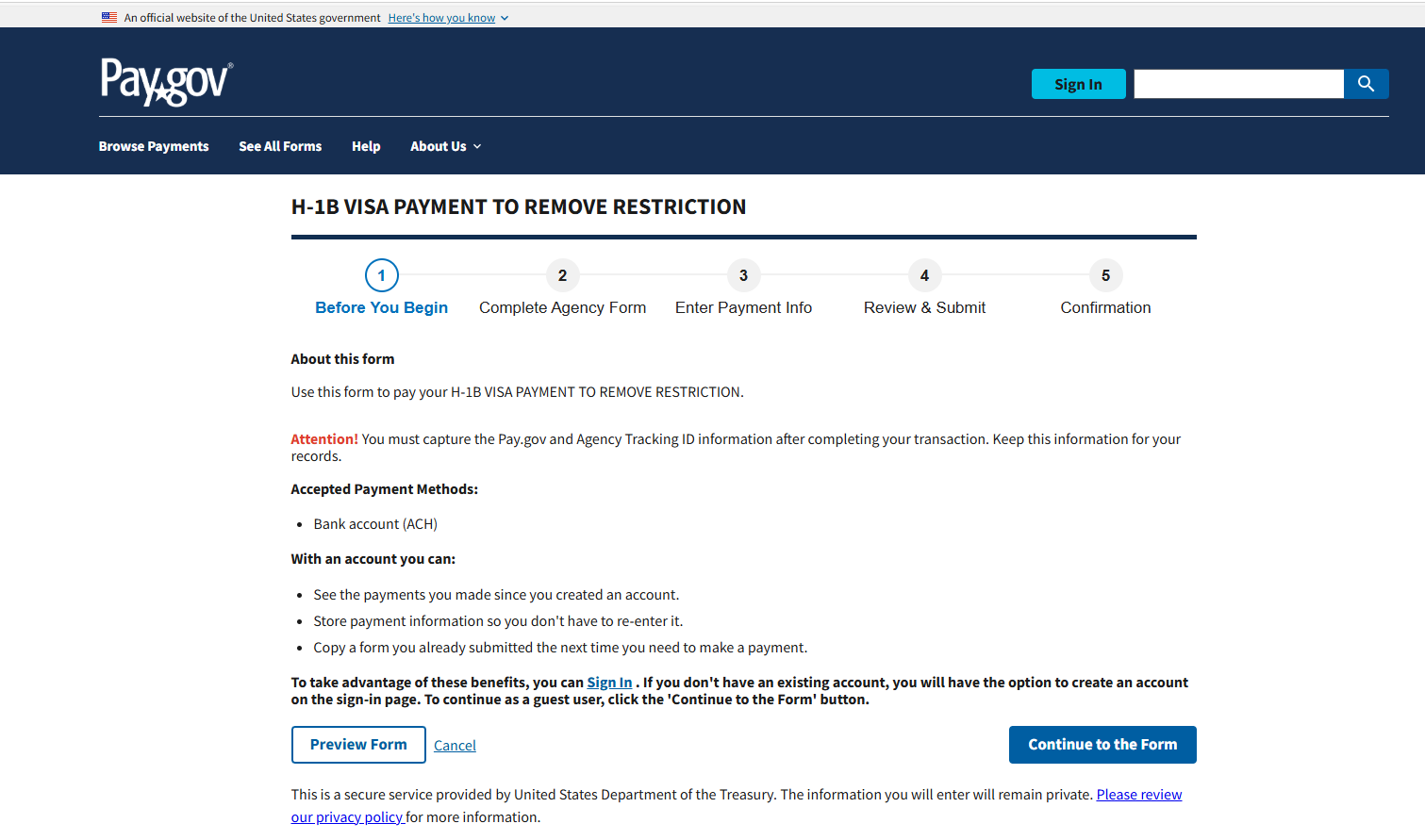Latest! Implementation Details of $100,000 H-1B Visa Announced
On October 20, 2025, the United States Citizenship and Immigration Services (USCIS) released the latest guidelines on the $100,000 application fee for H-1B visas, clarifying the scope of application and exemption conditions. Let's take a look with the World Trade Group.

Situations requiring the $100,000 fee
1. The applicant is outside the United States and does not have a valid H-1B visa, and the employer submits a new H-1B application for them (on or after midnight, September 21, 2025).
2. The applicant is in the United States but needs to apply for an H-1B visa through consular notification, port of entry notification, or pre-flight inspection due to reasons such as status invalidation or departure.
3. Submitting an application for status change, extension, or amendment within the United States, but USCIS determines the applicant is not eligible (such as having no valid non-immigrant visa, or the applicant leaves the U.S. before the status change request decision, causing the status conversion to fail).

Situations not requiring the $100,000 fee
1. Applicants who already hold a valid H-1B visa are not affected by entry, exit, or renewal.
2. H-1B applications submitted before September 21, 2025, will continue to be processed under the old rules.
3. Applicants in the United States, applying for H-1B through "status change" or "visa extension" with a legal status (such as F-1/OPT), and have not left the country before approval, are not subject to the $100,000 additional fee. If the applicant is approved for an H-1B visa within the United States and then leaves and re-enters, as long as they hold a currently valid H-1B visa, they are not considered subject to this fee.
4. Applicants transitioning from F-1 student status to H-1B within the United States are not affected even if they later exit and re-stamp.

Payment method
Employers must pay the $100,000 through Pay.gov (https://www.pay.gov/public/form/start/1772005176) before submitting the H-1B application and submit the payment receipt with the case. If the "national interest waiver" condition of the Secretary of Homeland Security is met, a waiver certificate must be attached. Applications without the required receipt will be rejected.

Exemption conditions
The Secretary of Homeland Security can approve exemptions in "extremely rare" cases, subject to the following conditions:
(1) The work of the foreign employee is in the U.S. national interest;
(2) No American worker is available to perform the job;
(3) The foreign employee will not endanger U.S. security and welfare;
(4) Paying the fee will "seriously harm" U.S. interests.
This policy is not the "one-size-fits-all" approach initially feared by the public but a more refined adjustment: it will primarily affect applicants outside the country who do not yet hold a valid H-1B, while providing a certain "protective layer" for the student group who have studied and gained work experience in the U.S. This objectively alleviates the anxiety of the student community in the short term.
Although the current impact is limited, the trend has changed!
1) Short-term: The domestic path is more "stable," and anxiety is becoming controllable
Applicants studying and working in the U.S., as long as they maintain continuous legal status and complete status conversion/extension domestically, generally do not trigger the $100,000 additional fee. This provides compliance and cost predictability for a large number of students (F-1/OPT→H-1B).
2) Mid-term: Structural changes in quota competition
The high fee will significantly suppress direct overseas applications, pushing more demand into the domestic application pool, with the competition focus shifting more towards U.S. domestic university graduates and those already working in the U.S.
3) Employer side: Dual considerations of cost and compliance
Faced with increased costs and process uncertainties, corporate human resource strategies may change: recruitment preferences may shift towards talent already in the U.S. who can directly complete status conversion, reducing reliance on H-1B. For example, Tata Consultancy Services—one of the largest visa employee employers in the U.S., approved for 5,505 H-1Bs in 2025, second only to Amazon's 10,044—has stated that it will stop recruiting new employees through H-1B in the future, shifting to "local first" to implement the strategy of "reducing visa dependency." In other words, even top employers known for H-1B are beginning to prefer "only hire locally, less visa," indicating a clear shift in employment trends.

4) The linkage risk with the "salary lottery" logic
In the future, the lottery will shift to salary level as a key variable, amplifying the quota advantage of high-salary positions and top offers; relatively, entry-level/new graduates and small to medium-sized enterprise positions will face increased pressure. Under the cumulative effect of the new $100,000 case threshold, the competition focus will further tilt towards high-salary, U.S.-based, stable status applicants and employer combinations.
Identity Precedence:
From "seeking a visa" to "matching identity"
In this context, identity stability has become the primary variable in academic and career planning: uncertainties in any link such as lottery, status invalidation, or departure will translate into uncertainties in opportunity and time costs, and a single offer is difficult to hedge against policy and quota fluctuations.
As a result, more and more families are beginning to plan identities in advance, taking EB-5 as the main path: aiming to obtain green card status, with a more predictable path that does not rely on employer sponsorship and salary weight; identity first, career choice and geographic choice are freer, and children's education and family settlement progress simultaneously.
Since the implementation of the "Reform and Integrity Act" in 2022, EB-5 has ushered in three key innovations: sufficient reserved visa quotas, enjoying exemption from waiting periods; rural EB-5 projects, enjoying priority review rights; allowing "dual filing" applications, simultaneously submitting I-526E and I-485 applications, and obtaining a Combo card in about 3 months, achieving legal residence and work. Now is the best time to immigrate through EB-5.
It is worth noting that the EB-5 grandfather clause has entered the final year countdown (expires on September 30, 2026). Applications submitted before this date will be protected by current policies. Opportunities are fleeting, the earlier you submit, the more secure!
For detailed inquiries in Mainland China: 400-138-2929, Hong Kong Customer Service Center: (852)2802 8798